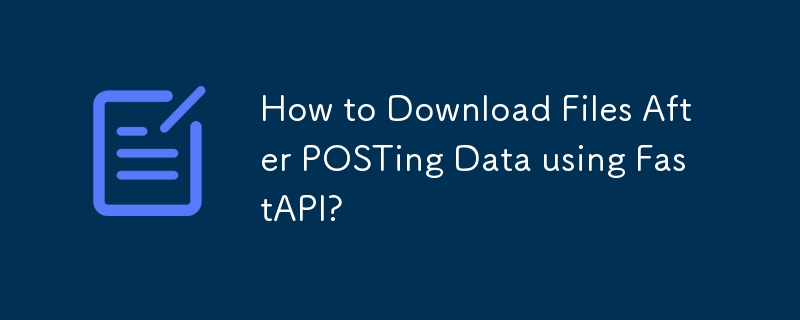如何使用 FastAPI 发布数据后下载文件?

使用 FastAPI POST 数据后下载文件
开发需要接收用户输入、处理用户输入然后提供文件下载的 Web 应用程序时,能够适当促进这种交流至关重要。 FastAPI 为构建此类应用程序提供了一个强大的框架,本指南将探讨如何在处理 POSTed 数据后有效下载文件。
实现函数
首先,在 FastAPI 应用程序中定义一个端点处理文件下载请求。该端点将接收文件路径并返回文件作为响应。使用 FastAPI FileResponse 类的示例实现:
<code class="python">from fastapi import FastAPI, FileResponse, Request
from fastapi.responses import FileResponse
app = FastAPI()
@app.post('/download-file')
async def download_file(request: Request, user_id: int = Form(...)):
file_path = 'path/to/file.mp3'
return FileResponse(file_path, media_type='audio/mp3', filename='output.mp3')</code>在此代码中,file_path 变量应替换为需要下载的文件的实际路径。 media_type 和 filename 参数指定文件类型以及下载文件的名称。
使用 HTML 触发下载
定义端点后,将 HTML 表单合并到您的前端中触发对 /download-file 端点的 POST 请求并提供必要的 user_id 参数:
<code class="html"><form action="/download-file" method="post">
<input type="text" name="user_id" placeholder="Enter user ID">
<input type="submit" value="Download File">
</form></code>提交表单时,具有指定 user_id 的 POST 请求将发送到 /download-file 端点,该端点将处理该请求并返回文件以供下载。
处理大文件下载
如果文件下载的文件特别大,可以考虑使用FastAPI中的StreamingResponse类:
<code class="python">from fastapi import FastAPI, Response, StreamingResponse
@app.post('/stream-large-file')
async def download_large_file(request: Request, user_id: int = Form(...)):
file_path = 'path/to/large_file.mp3'
async def iter_file():
with open(file_path, 'rb') as f:
while chunk := f.read(1024):
yield chunk
return StreamingResponse(iter_file(), media_type='audio/mp3', filename='output.mp3')</code>这里,iter_file函数分块读取文件以减少内存消耗并促进文件的流式传输。
结论
按照上述步骤,您可以创建 FastAPI 应用程序,在 POST 操作后无缝处理文件下载。这使您的应用程序能够提供下载功能,丰富用户体验并更轻松地访问生成的文件。
以上是如何使用 FastAPI 发布数据后下载文件?的详细内容。更多信息请关注PHP中文网其他相关文章!

热AI工具

Undresser.AI Undress
人工智能驱动的应用程序,用于创建逼真的裸体照片

AI Clothes Remover
用于从照片中去除衣服的在线人工智能工具。

Undress AI Tool
免费脱衣服图片

Clothoff.io
AI脱衣机

Video Face Swap
使用我们完全免费的人工智能换脸工具轻松在任何视频中换脸!

热门文章

热工具

记事本++7.3.1
好用且免费的代码编辑器

SublimeText3汉化版
中文版,非常好用

禅工作室 13.0.1
功能强大的PHP集成开发环境

Dreamweaver CS6
视觉化网页开发工具

SublimeText3 Mac版
神级代码编辑软件(SublimeText3)
 Python vs.C:申请和用例
Apr 12, 2025 am 12:01 AM
Python vs.C:申请和用例
Apr 12, 2025 am 12:01 AM
Python适合数据科学、Web开发和自动化任务,而C 适用于系统编程、游戏开发和嵌入式系统。 Python以简洁和强大的生态系统着称,C 则以高性能和底层控制能力闻名。
 您可以在2小时内学到多少python?
Apr 09, 2025 pm 04:33 PM
您可以在2小时内学到多少python?
Apr 09, 2025 pm 04:33 PM
两小时内可以学到Python的基础知识。1.学习变量和数据类型,2.掌握控制结构如if语句和循环,3.了解函数的定义和使用。这些将帮助你开始编写简单的Python程序。
 Python:游戏,Guis等
Apr 13, 2025 am 12:14 AM
Python:游戏,Guis等
Apr 13, 2025 am 12:14 AM
Python在游戏和GUI开发中表现出色。1)游戏开发使用Pygame,提供绘图、音频等功能,适合创建2D游戏。2)GUI开发可选择Tkinter或PyQt,Tkinter简单易用,PyQt功能丰富,适合专业开发。
 2小时的Python计划:一种现实的方法
Apr 11, 2025 am 12:04 AM
2小时的Python计划:一种现实的方法
Apr 11, 2025 am 12:04 AM
2小时内可以学会Python的基本编程概念和技能。1.学习变量和数据类型,2.掌握控制流(条件语句和循环),3.理解函数的定义和使用,4.通过简单示例和代码片段快速上手Python编程。
 Python:探索其主要应用程序
Apr 10, 2025 am 09:41 AM
Python:探索其主要应用程序
Apr 10, 2025 am 09:41 AM
Python在web开发、数据科学、机器学习、自动化和脚本编写等领域有广泛应用。1)在web开发中,Django和Flask框架简化了开发过程。2)数据科学和机器学习领域,NumPy、Pandas、Scikit-learn和TensorFlow库提供了强大支持。3)自动化和脚本编写方面,Python适用于自动化测试和系统管理等任务。
 Python与C:学习曲线和易用性
Apr 19, 2025 am 12:20 AM
Python与C:学习曲线和易用性
Apr 19, 2025 am 12:20 AM
Python更易学且易用,C 则更强大但复杂。1.Python语法简洁,适合初学者,动态类型和自动内存管理使其易用,但可能导致运行时错误。2.C 提供低级控制和高级特性,适合高性能应用,但学习门槛高,需手动管理内存和类型安全。
 Python和时间:充分利用您的学习时间
Apr 14, 2025 am 12:02 AM
Python和时间:充分利用您的学习时间
Apr 14, 2025 am 12:02 AM
要在有限的时间内最大化学习Python的效率,可以使用Python的datetime、time和schedule模块。1.datetime模块用于记录和规划学习时间。2.time模块帮助设置学习和休息时间。3.schedule模块自动化安排每周学习任务。
 Python:自动化,脚本和任务管理
Apr 16, 2025 am 12:14 AM
Python:自动化,脚本和任务管理
Apr 16, 2025 am 12:14 AM
Python在自动化、脚本编写和任务管理中表现出色。1)自动化:通过标准库如os、shutil实现文件备份。2)脚本编写:使用psutil库监控系统资源。3)任务管理:利用schedule库调度任务。Python的易用性和丰富库支持使其在这些领域中成为首选工具。






